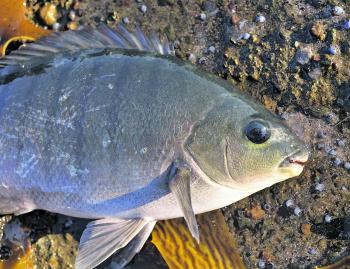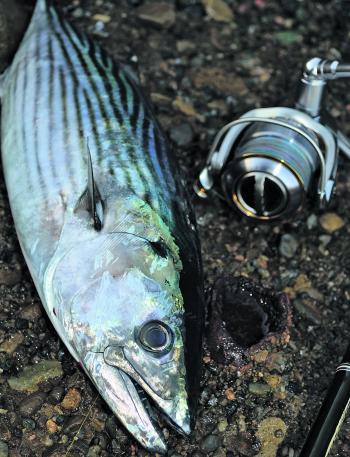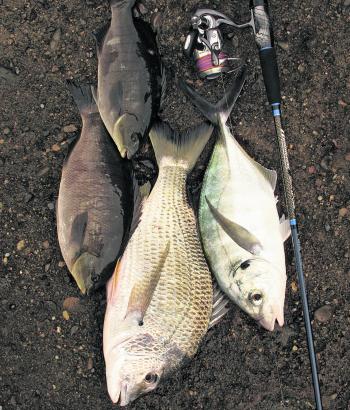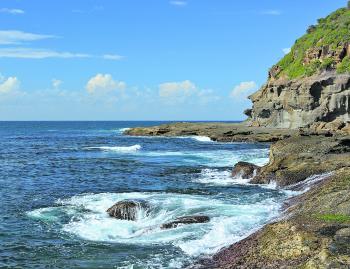Many keen anglers agree that autumn really hits the spot. Sure, there’s something good on offer during every month of the year, but for sheer variety of species, consistency of catch, and stability of weather, the next few months are hard to beat.
East coast rock hopping is particularly rewarding during autumn. Cool water species start to kick into gear, while warm water targets remain active. In other words, pretty much every type of fish can be caught from the rocks, so anglers can pick and choose their target, rather than just take what comes.
Weather patterns start to settle into a routine with large, slow moving high pressure systems dominating the atmosphere, plenty of blue sky days, light winds and calm seas. A decent patch of weather on the weekend or days off work are more likely.
However, the weather can blow up at any time of year. Sometimes a large high pressure system may centre itself over Tasmania and when it does, the NSW coastline can expect persistent onshore wind or rain from the southeasterly direction. It’s not entirely out of the ordinary for a very late cyclone to develop in the Coral Sea or one of those dreaded east coast lows to form. In April 2015 a very severe low pressure system that had the same force as a category two cyclone battered the Central Coast and Hunter regions.
Despite this generally calm time of year, it’s always a good idea to observe weather and sea forecasts before going rock fishing. Safety is a high priority and simple precautions like wearing suitable footwear, fishing with or near other anglers, and constantly keeping an eye on the water go a long way towards staying dry and safe.
Some of us are lucky enough to live within a short drive of various headlands, platforms and rocky outcrops. Here on the Central Coast I’m spoilt for choice, with all manner of rock fishing spots to choose from, and all offering something different.
In general, the more prominent headlands are better for pelagic species, from bonito to cobia and even billfish. Shallower rocky outcrops may be more suited to the likes of bream, luderick or tailor. That’s certainly not to say that big fish aren’t also possible in shallow, protected spots or that smaller bread and butter species can’t be caught from the end of a big headland. Each spot is different; some are better with wind coming from one direction, while another spot only 500m away fishes best when the wind blows the other way.
This is a similar occurrence when it comes to tides, time of day, swell height and the predominant species available. A good ledge for pelagics may also be great for drummer and groper, but not so good for bream and luderick. It’s largely a matter of knowing your home turf – talk to other anglers and see what else is caught while you’re fishing.
As much as I enjoy rock fishing, I also prefer to stay dry and feel safe, so it’s easier and more comfortable to concentrate on actually catching fish. So I won’t risk climbing down vertical cliffs or fish low ledges where waves constantly spill over. There’s simply no need to do so in order to get stuck into some excellent fishing.
Some of the standout rock fishing species that will feature over the coming weeks are bream, tailor, luderick, drummer, trevally, salmon, bonito, kingfish, mulloway and calamari squid. Others that may show up in some places include cobia, mackerel, mac tuna, yellowfin, longtail tuna and frigate mackerel.
We can roughly divide these into three groups; smaller foragers like bream, luderick and drummer, small predators from tailor through to rat sized kings and larger predators such as mackerel, mulloway and larger kingfish.
The first category, the foraging fish, respond best to simple baitfishing techniques and are caught in relatively shallow, washy spots close to your feet. Use baits like prawns, cunjevoi or white bread to catch a mixed bag of bream, drummer, luderick and trevally.
A more specific approach may be to use cut fish or pilchard baits for bream, cunjevoi for drummer and green cabbage for luderick. Even so, it’s still not uncommon for a bream to snatch green cabbage bait, trevally to eat pillies or luderick to take cunjevoi. All of these species are opportunistic, so they’ll take what comes if they’re hungry.
The small predators respond very well to lures, but most of them are also quite partial to pilchards, especially when used whole, on a set of ganged hooks. Most of the time it’s easy enough to catch tailor, bonito or salmon by lure casting, but like any species of fish, they can be touchy at times and this is when pilchard baits may still entice them.
As for lures, it’s hard to beat simple chrome metals in the 30-45g range. These lures interest pretty much any small pelagic in the vicinity, but are particularly effective on tailor and bonito. Alternatively, white or other light coloured metal lures can be very good as well and I’ve found they work slightly better than chrome when light levels are low, around sunrise or sunset.
Surface poppers from 70-150mm are another good lure to have in your tackle box. Cast around washy points very early in the morning or when it’s overcast and dull, and tailor will smash them. Bonito and salmon may also get in on the act and poppers can certainly stir up kingfish if they’re in the right mood.
Diving hardbody lures and soft plastics are also worth considering, as long as they can be cast far enough and retrieved in a manner that appeals to fish. Slinky white or natural coloured softies are very effective on kingfish, more so when they’re worked with a fast, zippy retrieve.
Lure casting can also work when it comes to chasing the larger predators, but in most cases it’s hard to go past live baiting as the best technique. Small yellowtail are common around most rocky ledges and aren’t too difficult to catch on bait jigs or tiny hooks baited up with a piece of prawn, squid or pillie. Garfish, pike and slimy mackerel are also possible in some spots, but any of these small baitfish can become quite flighty and hard to catch if larger predators are in the vicinity.
Freshly caught calamari squid are excellent bait, and kingfish and mulloway find them hard to resist. A live calamari squid cast or drifted under a float will not last long at all if a kingfish spots it. In fact, this is as close to a sure bet as anything in fishing!
One rod and reel can cover most of what’s on offer at this time of year and that outfit comprises a lightweight 3m rod and medium size threadline reel spooled up with 6-8kg line. Despite the popularity of braid, good old nylon mono still works pretty well for most forms of rock fishing.
Braid does have some advantages though and casting distance is one of them. A fine diameter braid of the same breaking strain as mono can achieve 20-30% greater distance. This is an obvious benefit when spinning for pelagic predators. Bear in mind that a mono leader roughly the same length as the rod is still required. The main purpose of this is to provide a form of cushion between rod tip and the fish. This safeguards against sudden lunges, erratic head shaking and generally helps to keep the hooks in place.
Repetitive lure casting for hard fighting fish is very demanding on reels, so if you’re planning on doing a lot of spinning then it really pays to buy a decent quality reel, rather than skimp out on a budget priced model. The gear ratio is another thing to consider, as a faster retrieve works much better on speedy fish like small tuna and bonito.
Of course, if those big predators are on the hit list then a sturdy overhead or big Alvey sidecast outfit could be a better option. There are some excellent threadline reels on the market these days that hold plenty of line and have powerful drag systems which can deal with most fish you’re likely to encounter from the rocks.
Regardless of the exact style of fishing or target species, it’s a good idea to keep everything to a minimum, rather than hauling along gear that’s probably not going to be used. This approach means it will be easier and more comfortable to walk in and out of the location. Remember that you may want to bring back a feed of fish and this only adds more weight or bulk.
Stay safe on the rocks this autumn and enjoy what’s on offer. It really is a fantastic time to spend a morning or whole day taking in the scenery, filling the lungs with fresh air and scoring some tasty seafood in the process.
Reads: 4158
Autumn is tailor time along most of the NSW coastline. These fish were caught at Norah Head casting a small chrome metal lure early in the morning.

Although generally regarded as a winter species, luderick can be caught from the ocean rocks at any time of year. Luderick are one of the more reliable targets during autumn.

High speed spinning with metal lures or casting whole pilchards on ganged hooks from the deeper ledges and headlands are good ways to find bonito and other small pelagic predators at this time of year.

How’s this for a solid bream? The author used small bread baits under a bobby float and caught a few luderick when this beast got in on the action. Fish like this aren’t uncommon as the water begins to cool.

Silver trevally can show up in good numbers anywhere south of Port Stephens during autumn and into winter. Small baits of white bread, peeled prawns, pillies and squid work well on these hard fighting fish.

Mixed bags are common when using white bread as bait from the rocks. Bread mashed into a pulp with some seawater makes an excellent berley to attract the fish as well.

The author put in a few hours at a local rock ledge without hooking anything before this solid bream eventually found his bait. Another victim of white bread pinched over a small hook, presented close in under the whitewash.

These are ideal brilliant autumn conditions, with calm seas and plenty of whitewash close in around the rocks.




